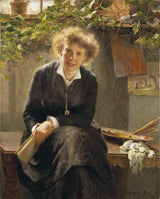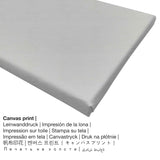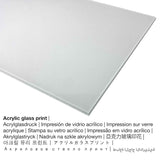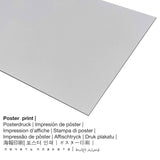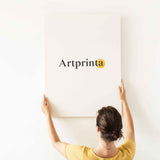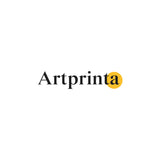Bertha Wegmann, 1881 - Onye nka Jeanna Bauck - mbipụta nka mara mma
Ụtụ gụnyere. Mbupu gbakọrọ na ndenye ọpụpụ.
"The Artist Jeanna Bauck" was made by the female artist Bertha Wegmann in 1881. The original had the following size: Height: 106 cm (41,7 ″); Width: 85 cm (33,4 ″) Framed: Height: 116 cm (45,6 ″); Width: 95 cm (37,4 ″); Depth: 6 cm (2,3 ″). Moveover, the artwork is in the the collection of Nationalmuseum Stockholm. This modern art ngalaba ọha A na-etinye ọrụ nka na nkwanye ùgwù nke Nationalmuseum Stockholm na Wikimedia Commons.Ihe kredit nke ọrụ nka bụ: . N'elu nke ahụ, nhazi nke mmepụta dijitalụ bụ Eserese ma nwee oke nke 1: 1.2, nke pụtara na ogologo bụ 20% mkpụmkpụ karịa obosara.
Original information about the work of art by Nationalmuseum Stockholm website (© Copyright - Nationalmuseum Stockholm - www.nationalmuseum.se)
English: Wegmann grew up in Denmark and trained as an artist in Munich, where she became friends with the Swedish painter Jeanna Bauck (1840–1926). They both moved to Paris in 1881, the year that this informal portrait of Bauck, sitting on a table with a book in her hand, was painted. The light enters through the studio window behind her, illuminating her blonde hair. Next to her lies a palette and some brushes. Wegmann created around 20 portraits of Jeanna Bauck – and Bauck in turn painted Wegmann several times. Porträttet av Jeanna Bauck är målat av danska konstnären Bertha Wegmann 1881. Några år tidigare hade Bauck gestaltat Wegmann i deras gemensamma ateljé i München men nu hade de flyttat till Paris och det var Baucks tur att sitta modell i deras nya arbetsplats. Jeanna Bauck sitter på ett okonventionellt sätt på ett bord och möter betraktarens blick, hon är gestaltad med stor integritet och närvaro. I porträttet lyckades Bertha Wegmann kombinera tidens fria självständiga kvinnotyp, ”Den Nya Kvinnan”, med den borgerliga kvinnlighetens elegans. Bauck har sina yrkesattribut vid sin sida; penslar, palett och målartrasor. I handen håller hon en bok som skall symbolisera hennes roll som intellektuell kvinna. I bakgrunden, genom fönsterrutorna, ser man takåsarna i Paris. Bertha Wegmann och Jeanna Bauck bodde tillsammans i Paris åren1880 och 1881. Båda konstnärerna lyckades komma in med flera verk på Paris-salongen och Wegmann erhöll en av de eftertraktade medaljerna. Vid den här tiden målade konstnärerna otaliga kamratporträtt, men det var endast kvinnorna som gestaltade varandra i yrkesrollen. Att ställa sig frågan vem och vad är jag, att offentligt skildra sig själva som subjekt är komplicerat för kvinnliga konstnärer i en tradition som skapats i enlighet med en patriarkal världsbild. I en rad banbrytande porträtt sökte Wegmann och Bauck därför att förändra synen på den kvinnliga konstnären och de bröt därmed med den förhärskande manliga konstnärsnormen. Jeanna Bauck återvände 1882 till München där hon grundade en målarskola för kvinnliga konstnärer. Bertha Wegmann flyttade tillbaka till Danmark, där hon fick sitt stora genombrott som porträttör på Charlottenborg utställningen 1883. Under perioden1887-1907 satt Wegmann i styrelsen för Tecknings- och konstindustriskolan för kvinnor i Köpenhamn och hon arbetade aktivt för att de danska kvinnliga konstnärerna skulle få tillgång till undervisningen på konstakademien. Många år efter Bertha Wegmanns död upprättades en stiftelse i hennes namn för obemedlade unga kvinnliga konstnärer.
Nkọwa ahaziri nke ihe osise
| Aha ọrụ nka: | "The Artist Jeanna Bauck" |
| Nhazi nka: | sere |
| Otu sara mbara: | nkà nke oge a |
| oge: | 19th narị afọ |
| Year: | 1881 |
| Ogologo afọ nka nka: | 130 afọ |
| Nha ihe osise izizi: | Ogologo: 106 cm (41,7 ″); Obosara: 85 cm (33,4 ″) Ekebere: Elu: 116 cm (45,6 ″); Obosara: 95 cm (37,4 ″); Omimi: 6 cm (2,3 ″) |
| Ụlọ ihe ngosi nka / ebe: | National Museum nke Stockholm |
| Ebe ngosi nka: | Stockholm, Obodo Stockholm, Sweden |
| Weebụsaịtị ihe ngosi nka: | National Museum nke Stockholm |
| Ụdị nka nka: | ngalaba ọha |
| Site n'aka: | Nationalmuseum Stockholm na Wikimedia Commons |
Banyere onye na-ese ihe
| Ihe nkiri: | Bertha Wegmann |
| A makwaara dịka: | Wegman Bertha, Bertha Wegmann, Wegmann Bertha |
| okike onye nka: | nwanyi |
| Obodo onye nka: | Danish |
| Ọrụ nke onye na-ese ihe: | onye na-ese ihe |
| Country: | Denmark |
| nhazi ọkwa: | omenkà nke oge a |
| Ndụ: | 79 afọ |
| Afọ ọmụmụ: | 1847 |
| Amụrụ na (ebe): | Soglio |
| Nwụrụ n'afọ: | 1926 |
| Nwụrụ na (ebe): | Copenhagen, Hovedstaden, Denmark |
Ngwa ngwaahịa a na-ahọpụta
The product dropdown menu ofers you the possibility to select the material and size of your choice. Thus, we allow you to choose among the following options:
- Ebipụta akwụkwọ mmado na ihe akwa akwa: Our poster is a UV printed canvas with a nice surface structure. It is appropriate for placing your art replica with a personal frame. Please bear in mind, that depending on the absolute size of the poster we add a white margin of something between 2-6cm around the print, which facilitates the framing with a custom frame.
- Mbipụta nke aluminom: Aluminium Dibond prints are metal prints with an outstanding effect of depth. The Direct Print on Aluminum Dibond is the excellent start to art replicas manufactured with aluminum. For the Direct Aluminium Dibond print, we print the artpiece on the aluminium white-primed surface. Colors are luminous in the highest definition, fine details are very clear, and you can notice a matte appearance of the art print surface.
- Mbipụta enyo acrylic: The print on acrylic glass, often denoted as a UV print on plexiglass, will convert your favorite original into beautiful home décor and offers a good alternative to canvas or dibond fine art prints. Your work of art is made with the help of modern UV printing machines. It makes vivid, deep print colors. The acrylic glass protects your custom art replica against light and heat for several decades.
- Mbipụta kwaaji: The canvas print is a printed canvas mounted on a wooden frame. In addition to that, a canvas print creates a nice, comfy ambience. Canvas prints are relatively low in weight, which implies that it is easy to hang up your Canvas print without the help of any wall-mounts. Canvas prints are suited for any type of wall.
Ngwaahịa a
| Ụdị ngwaahịa: | ọrụ mgbidi |
| Mmeputakwa: | dijitalụ mmeputakwa |
| Usoro mmepụta: | Mbipụta UV / dijitalụ |
| Mmalite nke ngwaahịa a: | arụpụtara na Germany |
| Ụdị ngwaahịa: | a na-achọ |
| Eji ngwaahịa a chọrọ: | gallery mmeputakwa nka, mkpokọta nka (mmeputakwa) |
| Nhazi: | usoro eserese |
| Njikwa oyiyi: | ogologo ruo obosara 1: 1.2 |
| Oke onyonyo pụtara: | ogologo bụ 20% mkpụmkpụ karịa obosara |
| Akwa ngwaahịa dị: | acrylic glass print (nwere ezigbo mkpuchi iko), mbipụta akwụkwọ mmado (akwụkwọ kwaaji), mbipụta kanvas, mbipụta ọla (aluminium dibond) |
| Ọdịiche dị n'okirikiri akwa akwa akwa (akwa akwa): | 50x60cm - 20x24", 100x120cm - 39x47", 150x180cm - 59x71" |
| Mbipụta iko acrylic (nwere ezigbo mkpuchi iko) nhọrọ nha: | 50x60cm - 20x24", 100x120cm - 39x47", 150x180cm - 59x71" |
| Nhọrọ nha nke akwụkwọ mmado (akwụkwọ kwaaji): | 50x60cm - 20x24", 100x120cm - 39x47" |
| Mbipụta nke aluminom (ihe aluminom): | 50x60cm - 20x24", 100x120cm - 39x47" |
| ụba: | enweghị etiti |
Ihe dị mkpa: We try what we can in order to describe our art products as clearly as possible and to demonstrate them visually. However, the tone of the printing material, as well as the imprint may vary marginally from the representation on the screen. Depending on the settings of your screen and the condition of the surface, not all colors will be printed one hundret percent realistically. Because all fine art prints are printed and processed by hand, there might as well be slight deviations in the motif's size and exact position.
Nwebiisinka © - Artprinta.com (Artprinta)

